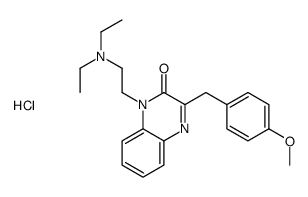55750-05-5
| Name | 1-[2-(diethylamino)ethyl]-3-[(4-methoxyphenyl)methyl]quinoxalin-2-one,hydrochloride |
|---|---|
| Synonyms |
Caroverine hydrochloride
Spasmium P 201-1 Tinnex Spadon Caroverine HCl |
| Description | Caroverine hydrochloride is a potent, competitive and reversible antagonist of NMDA and AMPA glutamate receptor. Caroverine hydrochloride is also an antioxidant and calcium-blocking agent that exhibits vasorelaxant action. Caroverine hydrochloride can be used for the research of inner ear tinnitus[1][2][3]. |
|---|---|
| Related Catalog | |
| Target |
NMDA[1] AMPA[1] |
| In Vitro | Caroverine (1 μM; pretreated for 10 min) inhibits the pressor response to KCl (80 mM) and noradrenaline (1 μM) in the rat hindquarter preparation. Caroverine markedly suppresses the contraction caused by KCl (40 mM) in the rat isolated aorta[3]. |
| In Vivo | Caroverine (1.44 mg/rat; s.c; 1.0 mL/h for 72 h) attenuates impulse noise-induced hearing loss in the rat[4]. Animal Model: Sprague-Dawley rats of either sex (250-300 g) received impulse noise exposure[4] Dosage: 1.44 mg/rat Administration: 20 mg/mL; s.c. 1.0 mL/h for 72 h Result: Significantly protected the cochlea against impulse noise trauma. |
| References |
| Density | 1.11g/cm3 |
|---|---|
| Boiling Point | 521.2ºC at 760mmHg |
| Molecular Formula | C22H28ClN3O2 |
| Molecular Weight | 401.93000 |
| Flash Point | 269ºC |
| Exact Mass | 401.18700 |
| PSA | 47.36000 |
| LogP | 4.13970 |
| Symbol |

GHS07 |
|---|---|
| Signal Word | Warning |
| Hazard Statements | H302 |
| Personal Protective Equipment | dust mask type N95 (US);Eyeshields;Faceshields;Gloves |
| Hazard Codes | Xn |
| Risk Phrases | 22 |
| RIDADR | NONH for all modes of transport |
